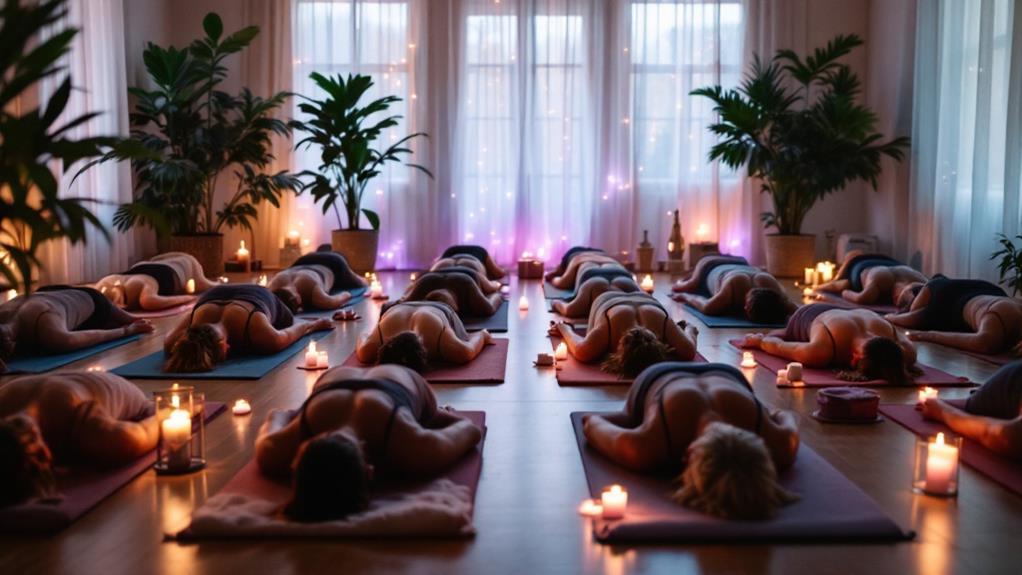Why You Should Practice Yoga Nidra for Complete Relaxation

Practicing Yoga Nidra offers you the ultimate path to complete relaxation by immersing both mind and body in a state of deep rest. As you lie in shavasana, you'll enjoy the benefits of reduced stress and anxiety, leading to a more peaceful state of mind. Regular sessions can greatly enhance your sleep quality, sometimes equivalent to 2-4 hours of restful sleep in just 30 minutes. Unlike traditional meditation, its guided nature guarantees accessibility, making it suitable for everyone. Welcome this practice to feel grounded and revitalized, with the promise of uncovering more transformative benefits as you continue the expedition.
Understanding Yoga Nidra
Yoga Nidra's roots reach back to ancient yogic traditions, offering a unique form of relaxation known as "yogic sleep." This practice guides you into a state of deep relaxation while you remain aware, bridging the gap between wakefulness and sleep. As a relaxation technique, Yoga Nidra stands out for its accessibility and simplicity. You usually practice it lying down in the shavasana position, allowing your body to fully relax while your mind follows a guided meditation. This process involves systematic body scanning and visualization techniques aimed at reducing stress and promoting mental clarity.
When you engage in Yoga Nidra, you're entering a hypnagogic state—a twilight zone between wakefulness and sleep. Here, your mind stays alert while your body slips into deep relaxation. This state is where stress management becomes effective, as it allows you to release tension and anxiety that you might carry throughout your day. The guided meditation helps focus your awareness internally, offering a mental clarity that's often elusive in daily life. With its minimal physical effort and adaptability to different settings, Yoga Nidra provides a powerful tool for achieving tranquility and clarity in a hectic world.
Benefits of Regular Practice
Imagine transforming your sleep quality and reducing stress levels with just a simple daily practice. Practicing Yoga Nidra regularly offers incredible benefits. You'll find that it greatly improves sleep. Participants who engage consistently for 60 days report faster sleep onset and deeper sleep cycles. This practice can be a game-changer for managing insomnia and improving restfulness, as a 30-minute session provides restorative benefits equivalent to 2-4 hours of quality sleep.
Reducing stress is another key benefit of Yoga Nidra. Regular sessions can lower anxiety and stress levels, making it an effective tool for everyone, from students to high-pressure professionals. It helps lower cortisol levels, which are linked to stress, potentially leading to improved heart rate variability and a stronger immune response.
Yoga Nidra also elevates cognitive function. You'll experience improved problem-solving abilities and emotional regulation. The practice promotes a shift from beta to theta brain wave states, fostering creativity and emotional processing. By incorporating Yoga Nidra into your routine, you not only improve sleep and reduce stress, but you also support your emotional and cognitive well-being. It's a holistic approach to achieving a balanced and healthier life.
Yoga Nidra vs. Meditation

When comparing Yoga Nidra and meditation, you'll notice key differences in practice and benefits. Yoga Nidra is performed lying down, inducing a sleep-like state while maintaining awareness, which leads to deep relaxation. In contrast, traditional meditation is usually done in a seated position, focusing on maintaining alertness. This difference in posture and approach can notably impact the level of relaxation you experience.
Yoga Nidra engages the parasympathetic nervous system more effectively than seated meditation, promoting greater stress reduction and relaxation. During the practice of Yoga Nidra, a systematic body scan is involved, allowing for deeper physical relaxation. This method is especially beneficial if you're seeking immediate relaxation. The guided instructions in Yoga Nidra offer a structured experience, making it accessible for beginners. It's a stark contrast to meditation, which might involve multiple techniques and postures, potentially overwhelming for newcomers.
Research highlights that a 30-minute Yoga Nidra session can equate to 2-4 hours of quality sleep, showcasing its restorative benefits. While both Yoga Nidra and meditation improve mindfulness and relaxation, Yoga Nidra provides a more profound sense of restfulness, making it a compelling choice for those looking to unwind effectively.
Improving Sleep Quality
Transform your sleep routine with the powerful practice of Yoga Nidra. This ancient technique can greatly enhance your sleep quality by promoting deep relaxation and easing stress and anxiety. Imagine achieving the equivalent of 2-4 hours of quality sleep in just 30 minutes of practice. That's the magic of Yoga Nidra. It activates your parasympathetic nervous system, which boosts relaxation and reduces stress, helping you fall asleep faster and enjoy deeper sleep cycles.
Think about the long-term benefits, too. After just 60 days of consistent practice, studies show remarkable improvements in sleep quality and effective insomnia management. The key lies in the relaxation techniques employed, which help lower cortisol levels—often the culprit behind stress-related sleep disturbances. Lowering these levels paves the way for a more restful night's sleep.
Additionally, participants in Yoga Nidra sessions report decreased anxiety levels, making it easier to shift into sleep. This reduction in anxiety not only facilitates sleep onset but also diminishes insomnia symptoms. By incorporating Yoga Nidra into your nightly routine, you're setting the stage for improved sleep hygiene and greater better sleep patterns. Give it a try and experience the restful nights you deserve.
Mental Health Advantages
How does Yoga Nidra contribute to mental well-being? It offers notable advantages for mental health by reducing stress and improving emotional regulation. When you engage in Yoga Nidra, you activate your parasympathetic nervous system, which promotes relaxation and helps mitigate your body's stress responses. This relaxation response can lead to lower cortisol levels, which are often linked to chronic stress.
Studies show that regular practice of Yoga Nidra can considerably decrease anxiety levels. Regardless of whether you're a college student facing academic pressures or someone recovering from trauma, the practice provides a safe space for emotional exploration. By allowing you to confront emotions without feeling overwhelmed, Yoga Nidra fosters improved emotional regulation and resilience.
Moreover, Yoga Nidra improves mood and emotional well-being, correlating with increased self-esteem and self-confidence, especially in adolescents and young adults. The calming effects of Yoga Nidra make it easier to manage negative emotions, empowering you to navigate life's challenges with greater ease. By integrating Yoga Nidra into your routine, you can experience these mental health benefits, providing you with a foundation for a healthier, more balanced life.
Relieving Menstrual Symptoms
Many people frequently find relief from menstrual symptoms through the practice of Yoga Nidra. If you're struggling with menstrual cramps or discomfort, this practice could be your answer. Yoga Nidra has been shown to alleviate pain, offering considerable relief for those enduring the challenges of their menstrual cycle. The relaxation it induces can work wonders, not only soothing physical discomfort but also easing mental burdens like anxiety and depression.
Imagine a practice that helps you feel more at ease during your period. Here's why you should consider Yoga Nidra:
- Physical Relief: Experience a reduction in menstrual cramps and digestive symptoms, enhancing your general comfort.
- Emotional Balance: Alleviate the anxiety and mood swings that often accompany menstruation, leading to improved emotional well-being.
- Hormonal Harmony: Benefit from decreased levels of menstruation-related hormones, contributing to the relief of symptoms.
Yoga Nidra's calming effects can greatly improve your menstrual experience. By practicing regularly, you might find yourself embracing your cycle with a newfound sense of calm and relaxation. Regardless of you're seeking to manage pain or reduce anxiety, Yoga Nidra offers a natural, effective path to relief.
How to Practice

Experiencing the soothing benefits of Yoga Nidra for menstrual relief is just the beginning. To practice yoga nidra effectively, start by finding a quiet, comfortable space where you can lie down in shavasana. Use a mat, blanket, or pillow to support your body. This will be your haven of relaxation. Begin with a few minutes of deep breathing to center your mind and prepare for a guided Yoga Nidra session.
During the session, a systematic body scan will be your guide, helping you bring awareness to each part of your body. This process releases tension and promotes deep relaxation, making it an excellent tool for boosting sleep. At the start, set a personal intention or sankalpa to focus your mind and improve the effectiveness of your practice.
For beginners, audio recordings from trusted sources or yoga instructors are invaluable. They make practicing Yoga Nidra accessible and easy to follow. Typically lasting between 20 to 40 minutes, these sessions provide a structured framework to guide you through each stage. Consistent practice can transform your relaxation routine, leading to restorative sleep and a calmer mind.
Managing Intense Reactions
Intense emotions can sometimes surface during Yoga Nidra, catching you off guard. When this happens, managing intense reactions becomes crucial to maintain your sense of calm. Grounding techniques, such as opening your eyes and taking deep breaths, can help you regain composure. Recognize that these intense sensations are mental projections, not reality, which can reduce anxiety and help you stay anchored in your meditation practice.
If distress continues, consider reducing the frequency of your sessions, allowing time for emotional processing and integration. Here's how to handle these moments effectively:
- Pause and Breathe: Slow down your practice and focus on deep, calming breaths.
- Engage in Soothing Activities: Follow your session with comforting actions like sipping tea or a gentle walk.
- Seek Guidance: Consult qualified meditation teachers or counselors to investigate deeper emotional layers or unresolved trauma.
These practices not only promote deep relaxation but also guarantee your mental health is prioritized. By acknowledging these reactions and using these strategies, you can transform them into opportunities for growth and healing, enhancing your complete Yoga Nidra experience.
Community and Resources

When steering through intense emotions during Yoga Nidra, finding a supportive community can be invaluable. Engaging with a community of practitioners offers encouragement and shared experiences that elevate motivation and dedication to your practice. You'll find that participating in group sessions fosters a sense of belonging and connection, which greatly contributes to your emotional and mental well-being.
Online platforms like Insight Timer and YouTube provide extensive resources for guided Yoga Nidra sessions. These platforms offer a variety of options catering to different preferences and skill levels, making it easy to access resources anytime. Regardless of whether you're a beginner or seasoned practitioner, exploring these guided sessions can improve your practice and relaxation outcomes.
Sharing your progress and insights within a community can lead to valuable feedback and new perspectives, enriching your complete Yoga Nidra experience. Engaging in discussions and exchanging resources like recommended recordings and techniques fosters continuous learning and growth. This continuous exchange not only improves your personal practice but also strengthens the community as a whole. By tapping into these resources and connecting with others, you'll find a supportive network that nurtures your well-being and guarantees a fulfilling Yoga Nidra experience.
Accessibility for Everyone
Yoga Nidra stands out as an inclusive practice that welcomes everyone, regardless of phase of life or physical ability. It's accessible to all life stages, from children to seniors, and requires only that you lie down or sit comfortably. This eliminates the need for intense physical effort or complex yoga poses, making it perfect for diverse populations. Regardless of being in bed or on the floor, Yoga Nidra offers a path to relaxation without the barriers that other practices might pose.
Imagine the benefits:
- Relief from Stress: Feel the weight lift off your shoulders as you sink into a state of deep relaxation.
- Quality Sleep: Experience restful nights and wake up feeling rejuvenated and ready to face the day.
- Accessible Anytime: Regardless of having 5 minutes or an hour, Yoga Nidra fits into your routine, making relaxation a daily habit.
Guided sessions guarantee you don't need prior meditation experience to participate. With flexible durations, Yoga Nidra can seamlessly integrate into your life, accommodating your unique schedule and preferences. Accept this practice and release the potential for profound relaxation and quality sleep, no matter your circumstances.




